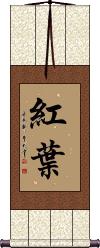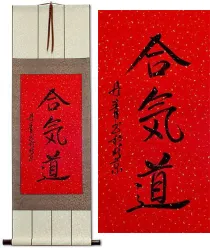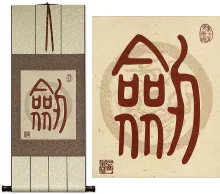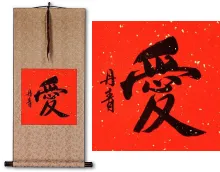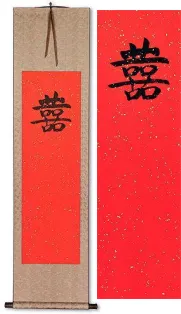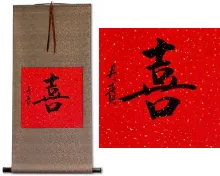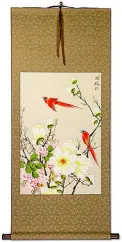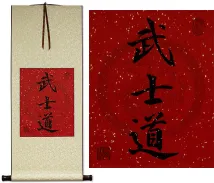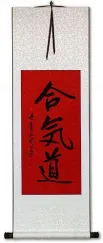Many custom options...
And formats...

Red Leaves of Autumn in Chinese / Japanese...
Buy a Red Leaves of Autumn calligraphy wall scroll here!
Personalize your custom “Red Leaves of Autumn” project by clicking the button next to your favorite “Red Leaves of Autumn” title below...
Red Leaves of Autumn
Mountain Travels Poem by Dumu
This poem was written almost 1200 years ago during the Tang dynasty.
It depicts traveling up a place known as Cold Mountain, where some hearty people have built their homes. The traveler is overwhelmed by the beauty of the turning leaves of the maple forest that surrounds him just as night overtakes the day, and darkness prevails. His heart implores him to stop, and take in all of the beauty around him.
First, before you get to the full translation, I must tell you that Chinese poetry is a lot different than what we have in the west. Chinese words simply don't rhyme in the same way that English or other western languages do. Chinese poetry depends on rhythm and a certain beat of repeated numbers of characters.
I have done my best to translate this poem keeping a certain feel of the original poet. But some of the original beauty of the poem in its original Chinese will be lost in translation.
Far away on Cold Mountain, a stone path leads upwards.
Among white clouds, people's homes reside.
Stopping my carriage I must, as to admire the maple forest at nights fall.
In awe of autumn leaves showing more red than even flowers of early spring.
Hopefully, this poem will remind you to stop, and “take it all in” as you travel through life.
The poet's name is “Du Mu” in Chinese that is: ![]()
![]() .
.
The title of the poem, “Mountain Travels” is: ![]()
![]()
You can have the title, poet's name, and even “Tang Dynasty” written as an inscription on your custom wall scroll if you like.
More about the poet:
Dumu lived from 803-852 AD and was a leading Chinese poet during the later part of the Tang dynasty.
He was born in Chang'an, a city in central China and the former capital of the ancient Chinese empire in 221-206 BC. In present-day China, his birthplace is currently known as Xi'an, the home of the Terracotta Soldiers.
He was awarded his Jinshi degree (an exam administered by the emperor's court which leads to becoming an official of the court) at the age of 25 and went on to hold many official positions over the years. However, he never achieved a high rank, apparently because of some disputes between various factions, and his family's criticism of the government. His last post in the court was his appointment to the office of Secretariat Drafter.
During his life, he wrote scores of narrative poems, as well as a commentary on the Art of War and many letters of advice to high officials.
His poems were often very realistic and often depicted everyday life. He wrote poems about everything, from drinking beer in a tavern to weepy poems about lost love.
The thing that strikes you most is the fact even after 1200 years, not much has changed about the beauty of nature, toils, and troubles of love and beer drinking.
This in-stock artwork might be what you are looking for, and ships right away...
Gallery Price: $108.00
Your Price: $59.88
Gallery Price: $106.00
Your Price: $58.88
Gallery Price: $232.00
Your Price: $128.88
Gallery Price: $65.00
Your Price: $39.88
Gallery Price: $90.00
Your Price: $49.88
Gallery Price: $65.00
Your Price: $39.88
Chinese Golden/Red Butterfly & Flower Painting
Discounted Blemished
Gallery Price: $53.00
Your Price: $29.00
Gallery Price: $72.00
Your Price: $39.88
Gallery Price: $87.00
Your Price: $47.88
Gallery Price: $60.00
Your Price: $36.88
Not the results for red leaves of autumn that you were looking for?
Below are some entries from our dictionary that may match your red leaves of autumn search...
| Characters If shown, 2nd row is Simp. Chinese |
Pronunciation Romanization |
Simple Dictionary Definition |
紅葉 红叶 see styles |
hóng yè hong2 ye4 hung yeh moyo もよ |
More info & calligraphy: Red Leaves of Autumn(n,vs,vi) (See 黄葉) leaves turning red (in autumn); red leaves; autumn colours; fall colors; (female given name) Moyo |
紅葉樹 see styles |
kouyouju / koyoju こうようじゅ |
tree whose leaves turn red in autumn |
Variations: |
kouyou(紅葉, 黄葉)(p); momiji(p) / koyo(紅葉, 黄葉)(p); momiji(p) こうよう(紅葉, 黄葉)(P); もみじ(P) |
(noun/participle) (1) autumn colours; fall colors; leaves changing color (colour); (noun/participle) (2) (紅葉, こうよう only) leaves turning red; red leaves; (noun/participle) (3) (黄葉, こうよう only) leaves turning yellow; yellow leaves; (4) (もみじ only) (See 以呂波紅葉) (Japanese) maple (Acer japonicum); (5) (もみじ only) (colloquialism) venison; (6) (See 紅葉襲) layered colors in garments, resembling autumn colors |
Variations: |
momiji(p); momiji もみじ(P); モミジ |
(1) (See カエデ) maple (tree); (n,vs,vi) (2) (See 紅葉・こうよう) red leaves (of autumn); autumn colors; leaves changing color; (3) (See 紅葉襲) layered colors in garments, resembling autumn colors; (4) (See 鹿肉) venison |
Variations: |
irozuku いろづく |
(v5k,vi) (1) to change color (of leaves in autumn); to turn red; to turn yellow; (v5k,vi) (2) to ripen (and change color); (v5k,vi) (3) to become sexually aware; to reach puberty |
The following table may be helpful for those studying Chinese or Japanese...
| Title | Characters | Romaji (Romanized Japanese) | Various forms of Romanized Chinese | |
| Red Leaves of Autumn | 紅葉 红叶 | moyo | hóng yè / hong2 ye4 / hong ye / hongye | hung yeh / hungyeh |
| Mountain Travels Poem by Dumu | 遠上寒山石徑斜白雲生處有人家停車坐愛楓林晚霜葉紅於二月花 远上寒山石径斜白云生处有人家停车坐爱枫林晚霜叶红于二月花 | yuǎn shàng hán shān shí jìng xiá bái yún shēng chù yǒu rén jiā tíng chē zuò ài fēng lín wǎn shuàng yè hóng yú èr yuè huā yuan3 shang4 han2 shan1 shi2 jing4 xia2 bai2 yun2 sheng1 chu4 you3 ren2 jia1 ting2 che1 zuo4 ai4 feng1 lin2 wan3 shuang4 ye4 hong2 yu2 er4 yue4 hua1 yuan shang han shan shi jing xia bai yun sheng chu you ren jia ting che zuo ai feng lin wan shuang ye hong yu er yue hua | yüan shang han shan shih ching hsia pai yün sheng ch`u yu jen chia t`ing ch`e tso ai feng lin wan shuang yeh hung yü erh yüeh hua yüan shang han shan shih ching hsia pai yün sheng chu yu jen chia ting che tso ai feng lin wan shuang yeh hung yü erh yüeh hua |
|
| In some entries above you will see that characters have different versions above and below a line. In these cases, the characters above the line are Traditional Chinese, while the ones below are Simplified Chinese. | ||||
Successful Chinese Character and Japanese Kanji calligraphy searches within the last few hours...
